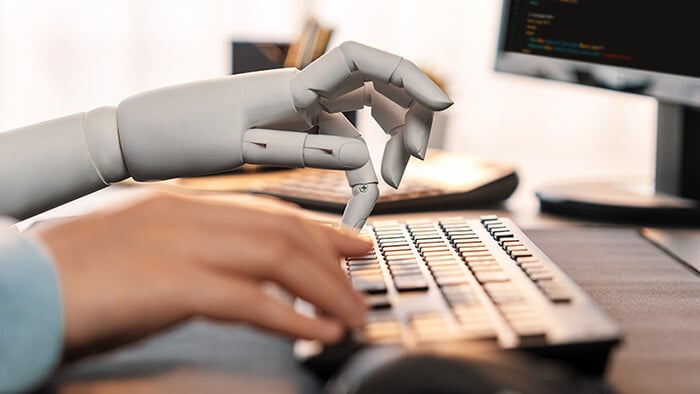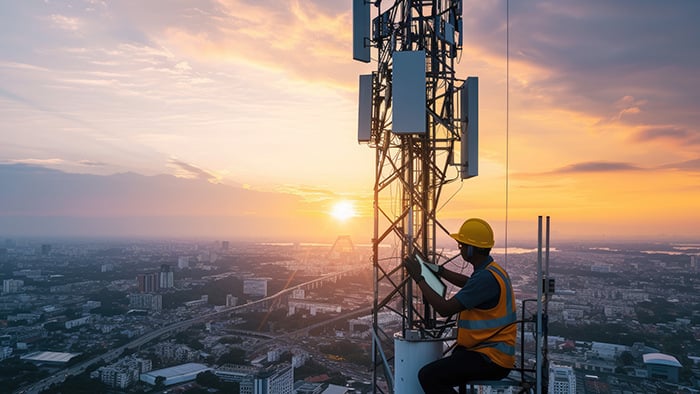What is the Internet of Things?
The Internet of Things (IoT) is a network of physical devices (things) embedded with special software and sensors, which allow them to connect and share data. Any object can be part of the IoT — from smart home gadgets to industrial tech tools — if it can be connected to the internet.
The definition of IoT also includes the massive network that connects devices, people, and even animals together through the cloud.
Internet of Things basics
Most IoT devices have some kind of sensor that lets them monitor various conditions. IoT devices can then “talk” to each other, or share data among themselves, the same way computers and smartphones can send and receive information without human interaction.
These days, companies are racing to add sensors and internet connectivity to all kinds of household items (from toasters to toilet paper holders to wine bottles) so you’re probably seeing these smart gadgets more and more while shopping online or during a trip to the department store.
Outside of the home, IoT’s advanced technology has wide-reaching commercial and industrial applications, which we'll get into later. First, understanding the Internet of Things requires a bit of backstory.
A brief history of IoT
The history of the Internet of Things began in 1982 with the very first connected device: a vending machine. This smart machine used its capabilities to monitor and report on its inventory (the inventors could go online to remotely check if their favorite soda was in stock and even if it would be cold). Although the smart vending machine didn’t really catch on, it did predict the large-scale use of industrial IoT, in which factories use IoT sensors to monitor all aspects of their supply chain and delivery processes.
Meanwhile, the actual name “Internet of Things” wasn’t coined until 1999 by tech pioneer Kevin Ashton. That same year, MIT professor Neil Gershenfeld wrote When Things Start to Think, which helped to explain and predict the IoT concept, although it didn’t use the actual term.
A number of other technological advances have propelled us toward the IoT world we now know.
RFID (radio-frequency identification) is a tagging system that allows items or devices to be tracked and categorized. It was traditionally used in the logistics industry (via chips) to do things like track containers as they get shipped around the world or monitor parts as they move through a production line. Large-scale tracking and monitoring of devices, parts, or things helped lay the groundwork for IoT. In fact, Ashton was working in RFID when he coined the term Internet of Things.
Building on RFID and combining it with internet capability, machine-to-machine (M2M) technology allows machines to connect, communicate with each other over a network, and make decisions without human interaction.
Various other wireless technologies, in conjunction with the proliferation of widespread, high- speed internet and ever-cheaper manufacturing costs, set the scene for IoT.
By 2008, the Internet of Things had advanced much further along. At this point, Cisco reported that there were more objects using the internet than people using it.
It may have started small, but IoT technology now promises to revolutionize society in countless ways, many of which we surely can’t even imagine yet.
How does the Internet of Things actually work?
Remember, the Internet of Things consists of ordinary devices that can connect to the internet and communicate with each other over the cloud. Generally, that means adding special sensors to ordinary items like washing machines, heating systems, refrigerators, watches, or almost anything else.
Some devices use these sensors to collect information and report it back. The first-ever IoT device mentioned above, a vending machine, used sensors to monitor its inventory and make that information available to the owner.
Other devices can receive information and then perform an action. For example, smart door locks receive a signal that you want them to open and then follow through by doing so.
The most sophisticated — and generally, most useful — IoT devices can do both. In industrial IoT, this could be a factory monitoring machinery components for possible malfunctions, and then raising the alarm when a problem is detected. In home-based IoT, this could be your smart thermostat, which collects information about your temperature preferences and habits, and then acts accordingly to heat or cool your home to the desired temperature depending on the time of day.
In general, smart technology helps things work better — more efficiently and with more synchronicity.
Most home IoT gadgets use your router to connect to a larger smart home, allowing you to use voice-activated commands or your smartphone to control many functions of your home to save time, energy, or both.
Commercially, IoT tech helps companies monitor and manage their factories, supply chains, and more. Sensors can also be added to a given part of some large-scale machinery, such as the drill of an oil rig, which can help improve production and safety.
How do IoT devices connect to each other?
IoT allows web-enabled devices to connect to each other and act on data that’s sent between them. Devices use the cloud to communicate, connecting over the internet using Wi-Fi, a cellular connection (3G or 4G), or Bluetooth.
Soon, 5G will engender even more futuristic possibilities, like driverless cars, fully interconnected cities, remote surgeries, and more advances that currently sound like a sci-fi movie.
What does IoT look like? You can picture a smart home as a spider. The body is the router, and each leg represents a connected device. The spider uses its web to connect with other spiders, communicate, and work together. With the rapid proliferation of IoT, we’ll soon have a spooky world covered with webs and spiders.
Or if spiders scare you, you can play it safe and just picture a nice fluffy cloud in the middle with connections to all of your devices.

How big is the Internet of Things now?
IBM posits that the typical family home will have about 500 devices connected to the internet by 2022. But that’s just one home! Worldwide, previous estimates cited a figure of 38.5 billion devices by 2020. An even newer analysis by Juniper Research actually suggests that the number of IoT sensors and devices will exceed 50 billion by 2022. Compare that to the world’s projected population of 8 billion, and you start to realize just how massive the IoT network truly is.
In fact, the sheer size of the IoT platform is difficult to accurately estimate, because it’s growing every day. It will soon become difficult to buy products that are not smart. With new companies forming and inventing IoT products every day (and people buying and connecting them daily), there is seemingly no limit to how big IoT can grow and what might happen with IoT over the coming decades.
Common examples of IoT devices
How many smart devices do you own? If you’re like most of us these days, you probably have quite a few.
You probably at least have a computer, a phone, and maybe a tablet.
How about appliances? You might have a smart TV, speaker system, coffee maker, or lock system. And what about a smart home system to bring it all together? Amazon Echo and Google Home devices help connect all of your smart home devices together.
Or perhaps you have some wearable IoT tech? From smart watches to Bluetooth headphones to smart shoes, there are many IoT devices you can wear directly on your body. Soon, IoT may even enter the human body, with smart medical devices like pacemakers.
Depending on where you work, you may also interact with IoT products and/or services in your workplace. Your office may use a commercial security system, IoT beacons to monitor employees coming and going, or other applications of smart technology.
These days, IoT is all around us, and it will only become more prominent as technology continues to advance.
The benefits of IoT
Why do we need the Internet of Things? Well, aside from the cool factor of having smart and shiny devices, IoT brings a host of benefits to both home and commercial settings.
Firstly, having smart sensors in your devices can improve convenience and efficiency. For example, smart lights or a smart thermostat can automatically turn off when you’re not at home to cut down on consumption and thus costs. When you have all of your devices linked together in a smart home, you’ll collect data on your habits and usage. Sometimes even just seeing statistics about your consumption can be eye-opening and shed light on what changes you can make to save time and/or money.
Furthermore, IoT can have safety applications. Smart door locks, alarms, and CCTV can make our homes much safer, while commercial security systems can shore up workplace security.
Why is IoT important?
IoT has rapidly become one of the most important technologies in our world. We can connect billions of devices together across the globe, which leads to seamless, nearly real-time communication 24/7 — all with minimal human intervention and relatively low costs.
Looking ahead, we’ll soon see even larger-scale applications of IoT tech with smart cities. As mentioned, 5G will really kick it up a notch — mainly due to its monstrously increased speed and vastly better connectivity.
Just try to imagine some of the possibilities: what if street lights had sensors that could interpret the weather conditions and adjust themselves accordingly? Or speed limit signs that could automatically adjust to traffic conditions and accidents? Or dumpsters with sensors that trigger faster and more efficient waste management services? Public transport, parking, and many other city services could get a huge makeover thanks to the marriage of IoT and 5G.

IoT could also be hugely beneficial in monitoring and reacting to environmental conditions. We could vastly improve things like forest fire detection, crop growing (monitoring soil conditions to control the flavor of grapes, and therefore, wine, for example), and controlling emissions to help with air pollution.
The possibilities are endless. And we definitely don’t have the full picture yet of how IoT will revolutionize the ways in which we live and work.
But it’s not all sunshine and roses with IoT.
The security and privacy implications of IoT
While IoT devices can enrich your life in some ways, they can also threaten it in others.
When assessing your security, you’re only as safe as your weakest link. You probably have antivirus software on your computer and iPhone (or Android), but what about your smart fridge? It only takes one unsecured IoT device to give hackers access to your entire network. For example, Avast researchers were able to hack a smart coffee maker, demonstrating how bad actors can infiltrate unsecured smart devices both to gain access to your network and to attack you with ransomware. Smart devices can also be recruited by hackers as part of a botnet army and used in a DDoS attack.
Unfortunately, any device that can get online can be compromised by malware.
Not only are computers, phones, and tablets more secure than other devices — because you probably use an antivirus or another virus scanner — they also get regular updates. These updates often patch security holes and fix other problems. When it comes to IoT gadgets, the companies may not always be committed to following up with updates.
Think about it: it’s not uncommon to have many household items (like refrigerators, toasters, dishwashers, etc.) for five to ten years. But can you really count on a company to maintain updates on that toaster for a whole decade? What if they get busy with other products? What if they go out of business? With companies these days rushing to get to market with the Next Big Thing, they may leave security by the wayside, so it’s important you do your own due diligence on securing your devices.
Unfortunately, the more devices we use, the more risk we introduce.
IoT also presents a murky situation privacy-wise. Just think about how much data a fully-equipped smart home collects on you:
-
 Smart door locks: what time you generally are home; who comes to your home at what times; how long they stay
Smart door locks: what time you generally are home; who comes to your home at what times; how long they stay
-
 Smart fridge: what you generally eat; when you generally eat; what could be missing from your diet
Smart fridge: what you generally eat; when you generally eat; what could be missing from your diet
-
 Smart speakers: what the weather’s like in your area; what topics you’re interested in searching about; what music you’re listening to; any conversations you have around the speaker that may accidentally get recorded
Smart speakers: what the weather’s like in your area; what topics you’re interested in searching about; what music you’re listening to; any conversations you have around the speaker that may accidentally get recorded
-
 Fitness trackers: what activities you do; how healthy you are; what your fitness goals are; where and when you exercise; when you go to bed and how much sleep you get
Fitness trackers: what activities you do; how healthy you are; what your fitness goals are; where and when you exercise; when you go to bed and how much sleep you get
Put all this together and see how full a picture your IoT devices will be able to paint of your habits. Now consider if the providers of these devices have a privacy policy or if they are allowed to sell your personal data to third parties (you definitely want to choose brands that don’t do this!). You don’t want to feel like your smart gadgets are spying on you in your own home.
Meanwhile, IoT also presents new security and privacy challenges to businesses. The more a business uses IoT technology, the more attack surfaces exist for cyber criminals to take advantage of. So companies need to be especially careful to secure their entire business and protect against sabotage, exposure of sensitive data, and other threats.
Put a lock on your front door
You wouldn’t leave your door unlocked when you leave your house. Leaving your IoT network unsecured could be just as dangerous as leaving your doors wide open, when you consider the potential for loss of personal property and private information. So, your digital domicile needs protection just as badly as your physical home does.
We’ll help you create an internet of safer things by adding an extra layer of protection to your home Wi-Fi network and devices. Our free Avast Free Antivirus protection includes real-time threat detection, which provides instant alerts if something isn’t right and will block intruders immediately with our state-of-the-art Firewall.
As we move forward into the future of smart cities, connected workplaces, and fully digital homes, network security is more important than ever. Get full security on all your devices everywhere you connect with Avast Antivirus.
















